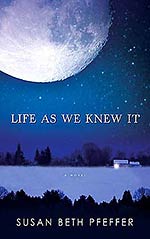
![]() Badseedgirl
Badseedgirl
7/7/2013
![]()
What happens to society after the apocalypse? Books, TV and movies are filled with examples of society breaking down into a depraved and brutal landscape and people. But what would happen if instead of society ending in a blaze of violence and brutality, it simply faded away? This is what Life As We Knew It by Susan Beth Pfeffer attempts to answer.
The novel is written in Journal format by a 16 year old typical American Teen girl named Miranda, living with her divorced mother and younger brother in rural Pennsylvania, On May 18th an asteroid collides with the moon. The asteroid was not a surprise. Everyone knew it was coming but it was not supposed to be anything to worry about. The impact occurred, but something was wrong, we ultimately find out that the asteroid was heavier, denser that calculated by astronomers, and it changed the orbit and distance the moon was from the planet.
What was most surprising to me was how very gentle this novel about the death of most of humanity is. I was expecting something in the vein of Lucifer's Hammer by Larry Niven. Violence, looting, rape, murder, you know, all the things that happen as society breaks down due to an world –wide natural disaster. There are plenty of natural disasters in this novel; Tsunamis, earthquakes, volcanos, and the resulting "Nuclear Winter" from the ash. It's just that the people in the novel never completely collapse into the barbarism that post-apocalyptic novels tend to lean to.
Because of the nuclear winter, Miranda's life starts to slowly shrink. As the novel progresses the reader can watch her physical and social circles constrict day by day. As winter strikes and food disappears people leave her community for warmer climates in the south, or out west. It is almost unbearable to watch Miranda struggle to maintain her relationships outside her family. She is a teenage girl and longs for romance and camaraderie of peers, but slowly and inevitably her friends and loves disappear due to migration or death, until by the middle and end of the novel her circle of support has dwindled to only family.
And what a family she has. It was painful to me to watch her Mom change from a strict but loving parent to a hard hearted Mother making decisions based solely on what will keep her children alive for one more day. I found it so very very sad to see her making decisions on the belief that only one of her children may survive the winter, and although she sacrifices more than she asks her children to give up; It was still physically painful to me to read how she chose her youngest child to be the "lucky" survivor child.
My problem with the novel, and it is a small one I can overlook without too much prejudice, has got to be the ending. I felt it was a bit forced. After the tone set by the rest of the novel, the ending just did not ring true to me. I will not say more, as I do not like to give spoilers in my review, but what I will say is that I really enjoyed this novel in spite of the ending. It was refreshing to see a different perspective on the end of the world. In Life As We Knew It, Susan Beth Pfeffer has written a post-apocalyptic novel about the people we WISH we were, and for that I give her praise.
4 of 5 stars